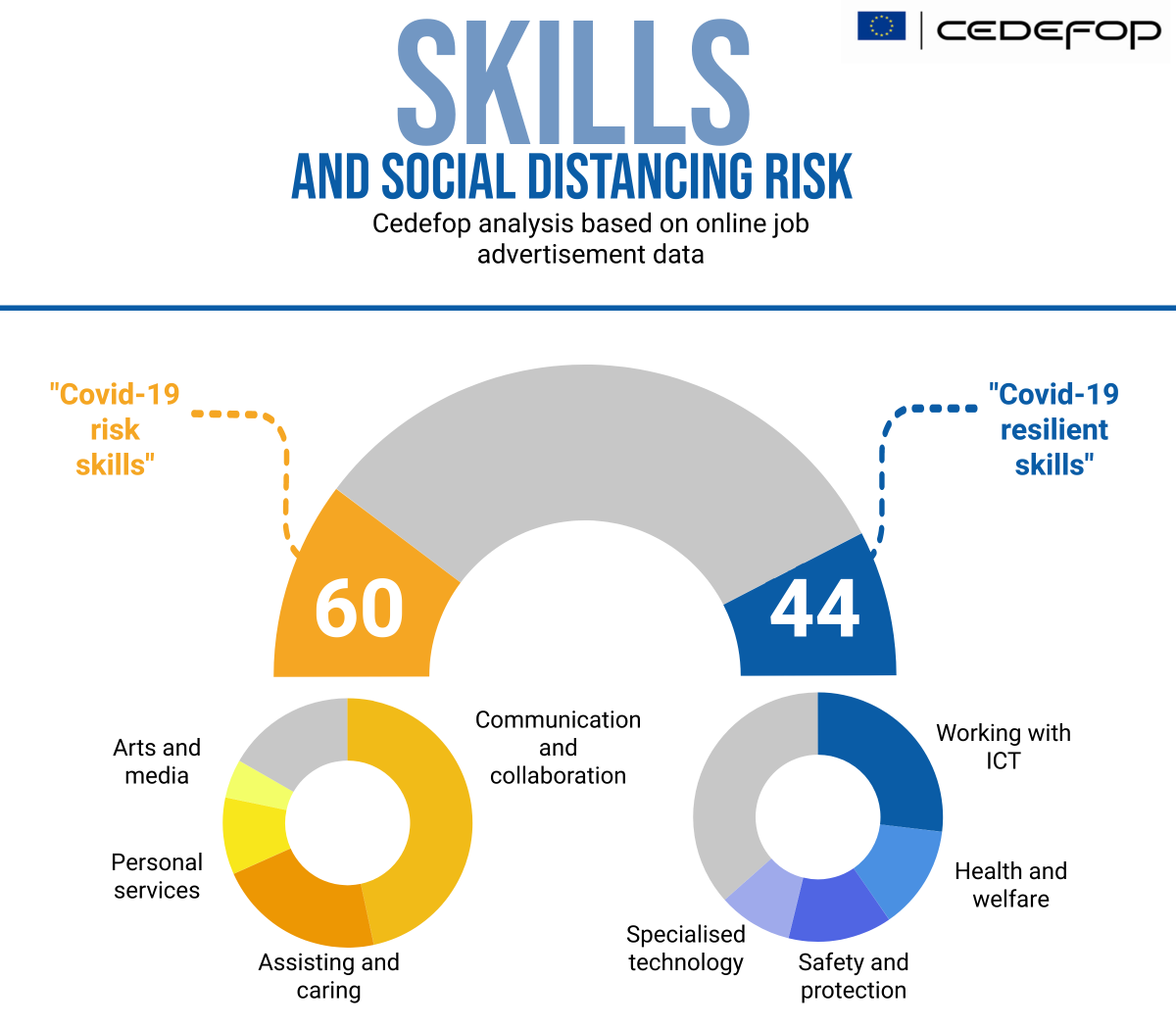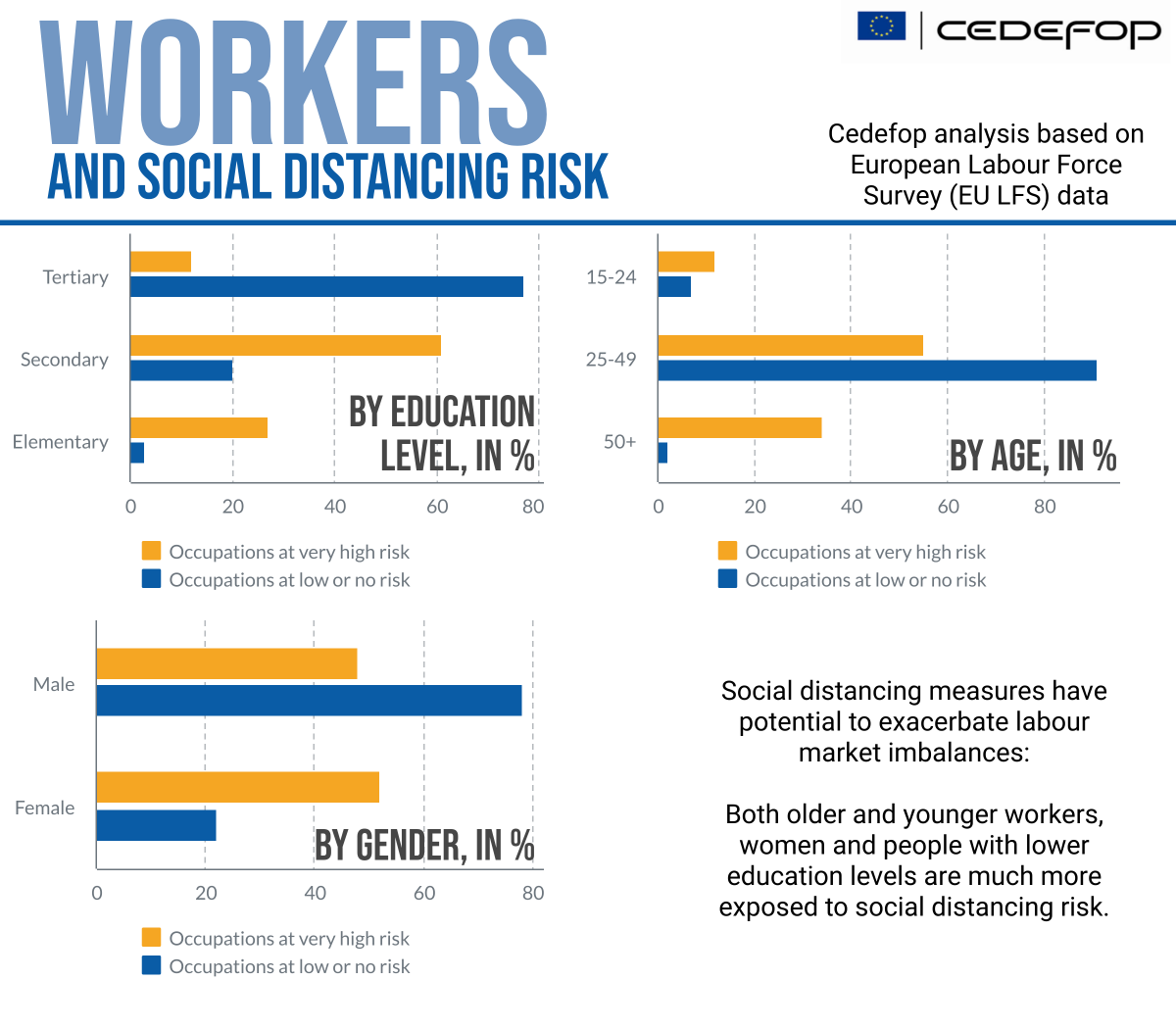You are here
- Home
- Publikácie a správy
- Data insights
- Covid-19 and jobs: Which skills make a difference?
Covid-19 and jobs: Which skills make a difference?
Summary
More than months have passed since European countries implemented strict and far reaching lockdowns to slow down the spread of Covid-19 and to save citizens’ lives. These measures impacted societies, workers and businesses on an unprecedented scale. Entire industries were temporarily shut down and although the countries have started to gradually ease these restrictions, early return to life and work as we knew it is unlikely.
Businesses in accommodation and food service, sport and cultural industries, retail and many other areas depending on traveling, gatherings of people and personal interaction expect a very tough period ahead.
Europe still waits to up-to-date data to assess the real labour market impact of travel restrictions and social distancing measures, although some early information on rising unemployment and falling search for jobs is already available. It will get worse as millions of people who rely on temporary summer work in accommodation and food service will find employment opportunities to be scarce.
Without actual data on the labour market impact of Covid-19, most of the current research, for example Cedefop’s Cov19R index, focuses on assessment of the potential risk of the pandemic for jobs and individuals. Using detailed skills information available in Europe as revealed by employers’ demands in online job advertisements, we explore what it can tell us about risk or resilience of occupations to social distancing measures.
Covid-19 and skills
The Cedefop Skills OVATE database now contains information about skills requirements in more than 67 million online job advertisements across Europe. Although the database does not cover all job opportunities available and a job ad often does not provide a full list of skills needed for an occupation, it is able to provide solid estimates on which skills give workers an edge in today’s labour market and which will be highly affected by social distancing measures, exposing them to high risk of either work disruption and reduced pay, or, worse, being laid off.
Using the ESCO skills database, we have classified a list of 292 aggregated skills that are requested in European online job ads using a similar methodology as with the Cov19R index. Namely we assess their dependence on personal social interaction, how essential they are to cope with the public health crisis and to provide basic services and their potential for being done remotely.
Out of these 292 skills, 60 were labelled as highly dependent on personal social interaction, mostly in areas of “communication, collaboration and creativity”, “assisting and caring for others”, “providing personal services” or “performing arts and media content production”.
44 skills we consider as mostly resilient to social distancing, as they have either high potential to be done remotely, such as in areas like “working with ICT”, “working with special technology” (such as medical or audio-visual equipment), or are necessary for provision of basic services such as in areas like “provision of health and welfare services”, “provision of safety and protection services”, “provision of food supply services”, or “packaging and delivery”.
Figure 1: Skills and social distancing risk

Source: Skills OVATE, own calculations
Covid-19 and jobs
For each of these 104 skills we have assessed how frequently they are requested across occupations – meaning what is the share of these skills on total skills requested per occupation. The higher the frequency of “social distancing risk” skills in an occupation’s job advertisements, the higher the exposure of people working in these occupations to Covid-19 countermeasures. The higher the frequency of skills that can be either done remotely or are associated with provision of essential services, the higher the chance people can continue to work or adapt to new work styles more easily. We hence compute an overall “disruption score” as follows:
Occupation disruption score: ∑ distancing risk - ∑ remote - ∑ essential
Out of 39 occupations we have analysed, 5 of them are exposed to very high social distancing risk with other 7 occupations exposed to high risk. In terms of employment, 15% of the European workforce is exposed to very high social distancing risk while another 15% to high distancing risk. At the same time, 7% of the EU workforce belong to occupations with a high concentration of “resilient” skills, namely those that can help them continue their tasks without major disruption.
These shares are a bit lower than those calculated in the Cedefop’s Cov19R index. It is worth to mention that the calculation here is based on different type of data (employee survey vs. online job advertisements) and works with different, more granulated skill detail. The Cedefop team now works of combining of both approaches, building on robustness of survey-type data and level of detail provided by online job advertisements.
Figure 2: Jobs and social distancing risk (in % share on total employment)

Source: Skills OVATE and EU-LFS 2018, own calculations
Covid-19 and sectors
What does this mean for businesses and organisations that employ people exposed to different levels of social distancing risk?
Employing a high share of people exposed to such risk means it is very likely that key business or organizational activities will be severely disrupted. For example, while an accounting clerk in a restaurant has a very low exposure risk as compared to a waiter, disruption of the main activity of the restaurant represents a danger for both employees, who may experience reduced pay or even be laid off if the establishment shuts down.
Therefore, in our analysis we also examine the employment structure across European economic sectors. We assess the risk or resilience of sectors by looking at share of people with high and low social distancing risk employed within a sector.
We calculate the risk score of a sector as the difference between the number of people employed in occupations that have high or very high social distancing risk and those with low or no social distancing risk.
Figure 3: Sectors and social distancing risk (workers’ groups in % share on total employment within a sector)

Source: Skills OVATE and EU-LFS 2018, own calculations
“ICT services”, “Energy supply services”, “Professional services” and “Financial services” are ranked as sectors with the lowest risk of disruption in their activities as they mostly rely on workforce that is capable of working remotely and with little reliance on personal social interaction. In these sectors, the employment share in “resilient occupations” is at least 25 p.p. higher than in “risk occupations”. High share of digitalisation of these sectors is their main shield against any highly disruptive effects of the Covid-19 pandemic.
“Accommodation and food”, “Wholesale & retail trade”, “Arts & recreation”, “Transport & storage” and “Construction” are sectors with the highest risk of disruption by social distancing measures. In these sectors, the employment share in “risk occupations” is at least 25 p.p. higher than in “resilient occupations”.
Covid-19 and EU countries
How do the social distancing measures affect European countries and their labour markets? By looking at the employment share of the above-mentioned five highly impacted sectors, we estimate the overall disruption of social distancing measures in EU countries’ labour markets.
Figure 4: Countries and social distancing risk (high-risk sectors as a % share on total employment within a country)

Source: Skills OVATE and EU-LFS 2018, own calculations
In terms of employment, Cyprus, Spain, Malta, Bulgaria, Italy, Greece and all Baltic countries’ labour markets rely more on sectors with activities at high risk of disruption by the Covid-19 pandemic. Still, these 5 high-risk sectors create at least one third of jobs in every EU country. All European labour markets are bracing for very difficult times ahead, but the crisis may particularly exacerbate the EU’s North-South divide.
Covid-19 and workers
Covid-19 pandemic and Europe’s response to it is also likely to aggravate employment prospects of vulnerable groups of workers. Across the EU, young but also older-aged people, those with low education level and females always find it relatively harder to get jobs. Looking at the relative shares of different demographic groups across occupations at both very high and low or none social distancing risk, the Covid-19 pandemic may very well exacerbate such difficulties. Occupations that employ predominantly middle-aged, tertiary educated workers and men seem to have much better chances to withstand this unprecedented labour market disruption.
Figure 5: Workers and social distancing risk (share of demographic groups a % share on total employment within high and low risk occupations)

Cedefop continues to investigate the impact of the Covid-19 pandemic on European labour markets. Based on data from online job advertisements and Cedefop’s European skills and jobs survey data, we will bring you more detailed analysis on how EU labour markets and skill demands will continue to be affected in the post coronavirus era.
Data insights details
Table of contents
Page 1
SummaryPage 2
Covid-19 and skillsPage 3
Covid-19 and jobsPage 4
Covid-19 and sectorsPage 5
Covid-19 and EU countriesPage 6
Covid-19 and workers
